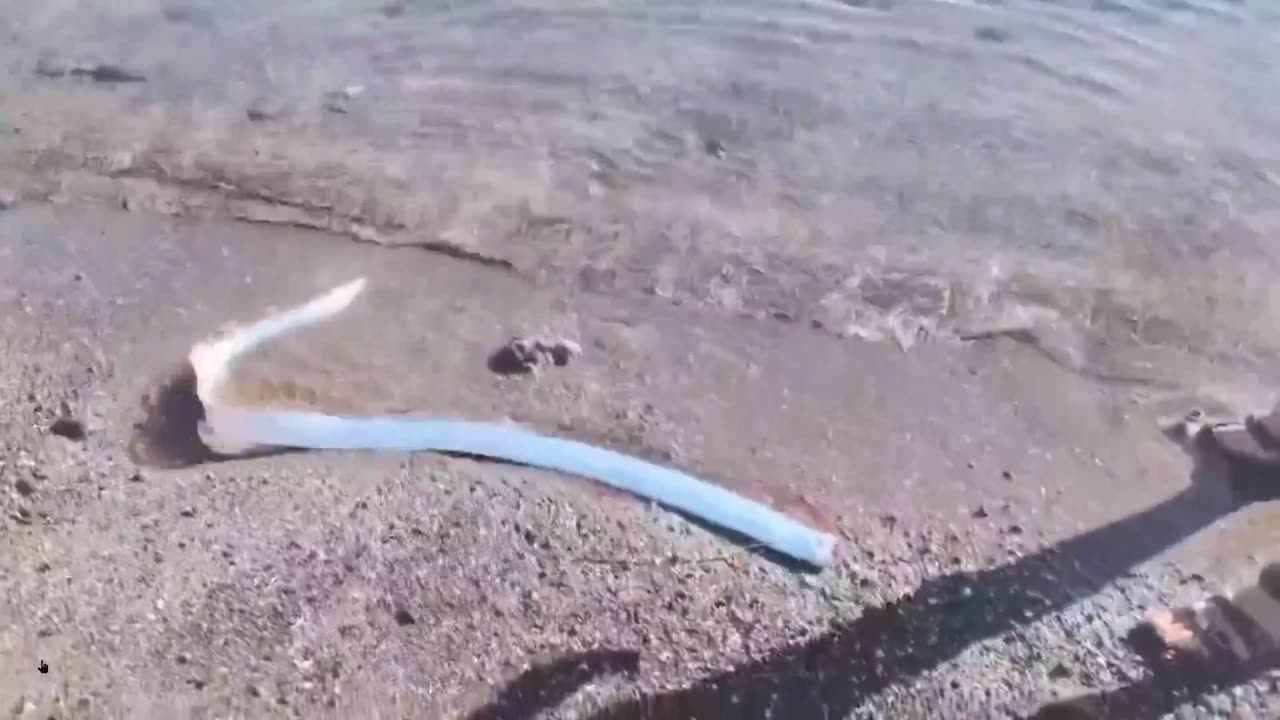Premium Only Content

Bet you never saw an Oarfish - they live deep in the ocean. This is a baby...
Here's some facts on it - This rarely seen deep-sea creature, known as an oarfish, washed ashore in Mexico. The creature in the video is indeed an oarfish, as confirmed by its distinctive long, ribbon-like body and silvery appearance, which matches descriptions of Regalecus glesne.
Oarfish sightings have been notably rare but increased in recent years, with multiple appearances in California in 2024, possibly due to changing ocean conditions, as suggested by researchers at Scripps Institution of Oceanography.
The oarfish's appearance in Mexico aligns with a global trend of deep-sea creatures surfacing more frequently, potentially linked to environmental changes or natural phenomena.
Oarfish are often referred to as "doomsday fish" due to cultural beliefs in Japan that their sightings precede earthquakes, though scientific studies, including one in 2019, have found no correlation.
Appearance: Oarfish are long, slender, silvery fish with a ribbon-like body. They can grow up to 36 feet (11 meters) or more, making them the longest bony fish in the ocean.
Habitat: They live in deep ocean waters, typically between 200 and 1,000 meters (650–3,300 feet), and are found in most oceans except polar regions.
Behavior: Oarfish are rarely seen by humans because they dwell in the deep sea. They’re often spotted near the surface when sick, injured, or dying, which contributes to their mythical reputation.
Diet: They primarily feed on plankton, small crustaceans, and jellyfish, using their small mouths to filter food.
Fins: Their long dorsal fin runs the length of their body, with some rays extending into crest-like structures on their head. They use these fins to "row" through the water, hence the name "oarfish."
Mythology: Oarfish are sometimes linked to sea serpent legends due to their snake-like appearance and rare surface sightings. In some cultures, they’re considered harbingers of earthquakes or storms, though no scientific evidence supports this.
Species: There are three known species: Regalecus glesne (giant oarfish), Regalecus russellii, and Agrostichthys parkeri.
Reproduction: Little is known, but they’re believed to spawn by releasing eggs into the open water, where larvae develop in the deep sea.
The News Variable Show of Whatfinger News, with Mal Antoni hosting... All controversial statements by Mr. Antoni are his own opinions. If you don't like them, don't watch. If you are one of those nut cases who watch just to complain, get a life or stick to fake news. We have no time for your BS. America needs patriots that just say it like it is. If you don't like it, too damn bad. Mr. Antoni is now the main editor over at Whatfinger News, the greatest aggregate news site out there - with more news and commentary daily than the next 7 competitors combined. Experience it once and you're hooked https://www.whatfinger.com/
------DISCLAIMER: This show contains opinions of the host and guests and is meant for education and/or entertainment purposes only. News Variable provides information and the sources where it was obtained. Viewer discretion is advised.
Email for any reason - [email protected] or check out my new account over at Twitter, Not used much yet but it is https://twitter.com/NewsVariable
How can you move your 401K to Gold penalty free? Get the answer and more with Goldco’s exclusive Gold IRA Beginner’s Guide. Click here now! – Goldco Partner of Whatfinger News 👍 see https://www.gcjdjhs3e.com/4RQSJ1/4B269N/?sub1=textad
Be prepared for anything, including lockdowns with your own Emergency Med kit – see Wellness Emergency Kit (includes Ivermectin and other essential drugs, guide book, much more… peace of mind for you and your family) 🛑 – Dr. McCullough’s company! Sponsor see https://www.twc.health/products/emergency-preparedness-kit?ref=_R9sg_nqDYD_C
-
 2:54:08
2:54:08
TimcastIRL
6 hours agoDemocrat FEDERALLY INDICTED For Obstructing ICE Agents In Chicago | Timcast IRL
205K97 -
 7:17:25
7:17:25
SpartakusLIVE
8 hours agoNEW - REDSEC Battle Royale || The Duke of Nuke CONQUERS ALL
44.5K8 -
 2:38:39
2:38:39
PandaSub2000
1 day agoNintendo DS Night | ULTRA BEST AT GAMES (Original Live Version)
21.5K17 -
 4:05:07
4:05:07
Alex Zedra
5 hours agoLIVE! Battlefield RecSec
27.9K9 -
 1:26:50
1:26:50
The Quartering
6 hours agoErika Kirk Threatened, SNAP Riots Near, & New AstroTurfed Woke Lib Influencer
52K26 -
 29:24
29:24
Glenn Greenwald
8 hours agoSen. Rand Paul on Venezuela Regime Change, the New War on Drugs, MAGA Rifts, and Attacks from Trump | SYSTEM UPDATE #539
131K112 -
 1:45:39
1:45:39
Badlands Media
20 hours agoAltered State S4 Ep. 3: EBT Riots, Shutdown Chaos & The Left’s Cannibalistic Meltdown
57.1K34 -
 2:07:35
2:07:35
This is the Ray Gaming
4 hours ago $0.43 earnedRedacted Sector Day 2 | Rumble Premium Creator
18.1K8 -
 4:23:15
4:23:15
SOLTEKGG
5 hours ago🔴LIVE - 30 + Kill Battle Royale - BF6 Giveaway
11.1K8 -
![[9 WINS] Battlefield 6 BR GRIND](https://1a-1791.com/video/fww1/3b/s8/1/6/c/1/u/6c1uz.0kob-small-9-WINS-Battlefield-6-BR-GRI.jpg) 5:21:51
5:21:51
StevieTLIVE
6 hours ago[9 WINS] Battlefield 6 BR GRIND
8.85K3